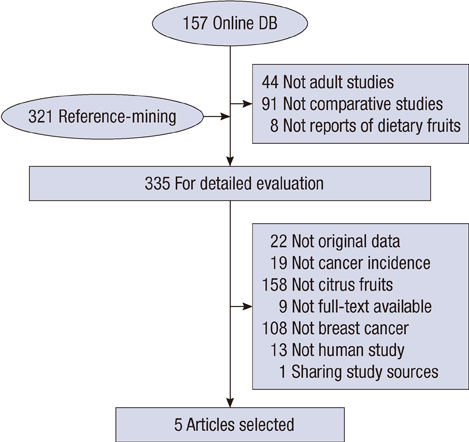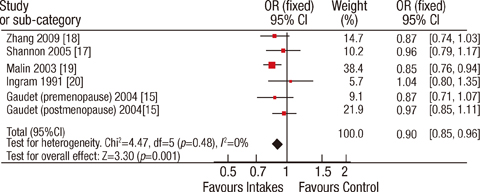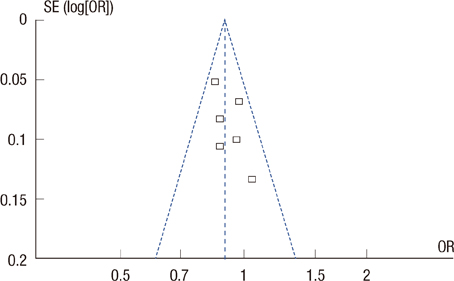J Breast Cancer.
2013 Mar;16(1):72-76.
Citrus Fruit Intake and Breast Cancer Risk: A Quantitative Systematic Review
- Affiliations
-
- 1Department of Preventive Medicine, Jeju National University School of Medicine, Jeju, Korea. jmbae@jejunu.ac.kr
Abstract
- PURPOSE
We investigated the association between dietary intake of citrus fruits and breast cancer risk.
METHODS
The PubMed and EMBASE were searched for relevant articles on diet and breast cancer up to January 2012. All of the epidemiological studies that assessed dietary intake of citrus fruits and presented risk estimates of the association between citrus fruits intake and risk of breast cancer were reviewed. Multivariable-adjusted odds ratios (OR) and associated 95% confidence intervals (CI) for highest versus lowest intake of dietary citrus fruits level were extracted. Overall summary OR was calculated by using a fixed-effect meta-analysis.
RESULTS
Six case-control studies out of five articles were eligible. Overall summary OR showed a 10% reduction in risk of breast cancer associated with high intake of citrus fruits (summary OR, 0.90; 95% CI, 0.85-0.96; p<0.001); results were consistent across the studies (I 2=0). Visual inspection of the results did not suggest a publication bias.
CONCLUSION
Pooled results from observational studies showed an inverse association between citrus fruits intake and the risk of breast cancer.
Keyword
Figure
Reference
-
1. National Cancer Center. Ministry of Health and Welfare. Cancer Facts & Figures 2011 in the Republic of Korea. 2011. Goyang: National Cancer Center, Ministry of Health and Welfare;7.2. Parkin DM, Fernández LM. Use of statistics to assess the global burden of breast cancer. Breast J. 2006. 12:Suppl 1. S70–S80.
Article3. World Cancer Research Fund. American Institute for Cancer Research. Food, Nutrition, Physical Activity, and the Prevention of Cancer: A Global Perspective. 2007. Washington, DC: WCRF/AICR;289–295.4. Shekelle RB, Lepper M, Liu S, Maliza C, Raynor WJ Jr, Rossof AH, et al. Dietary vitamin A and risk of cancer in the Western Electric study. Lancet. 1981. 2:1185–1190.
Article5. Franceschi S, Bidoli E, Negri E, Zambon P, Talamini R, Ruol A, et al. Role of macronutrients, vitamins and minerals in the aetiology of squamous-cell carcinoma of the oesophagus. Int J Cancer. 2000. 86:626–631.
Article6. Giovannucci E, Rimm EB, Liu Y, Stampfer MJ, Willett WC. A prospective study of tomato products, lycopene, and prostate cancer risk. J Natl Cancer Inst. 2002. 94:391–398.
Article7. Larsson SC, Håkansson N, Giovannucci E, Wolk A. Folate intake and pancreatic cancer incidence: a prospective study of Swedish women and men. J Natl Cancer Inst. 2006. 98:407–413.
Article8. Eichholzer M, Stähelin HB, Lüdin E, Bernasconi F. Smoking, plasma vitamins C, E, retinol, and carotene, and fatal prostate cancer: seventeen-year follow-up of the prospective basel study. Prostate. 1999. 38:189–198.
Article9. Knekt P, Aromaa A, Maatela J, Aaran RK, Nikkari T, Hakama M, et al. Serum vitamin E and risk of cancer among Finnish men during a 10-year follow-up. Am J Epidemiol. 1988. 127:28–41.
Article10. Zhang SM, Moore SC, Lin J, Cook NR, Manson JE, Lee IM, et al. Folate, vitamin B6, multivitamin supplements, and colorectal cancer risk in women. Am J Epidemiol. 2006. 163:108–115.
Article11. Willett WC, Polk BF, Morris JS, Stampfer MJ, Pressel S, Rosner B, et al. Prediagnostic serum selenium and risk of cancer. Lancet. 1983. 2:130–134.
Article12. Garcia-Closas R, Agudo A, Gonzalez CA, Riboli E. Intake of specific carotenoids and flavonoids and the risk of lung cancer in women in Barcelona, Spain. Nutr Cancer. 1998. 32:154–158.
Article13. Bae JM, Lee EJ, Guyatt G. Citrus fruit intake and stomach cancer risk: a quantitative systematic review. Gastric Cancer. 2008. 11:23–32.
Article14. Bae JM, Lee EJ, Guyatt G. Citrus fruit intake and pancreatic cancer risk: a quantitative systematic review. Pancreas. 2009. 38:168–174.15. Gaudet MM, Britton JA, Kabat GC, Steck-Scott S, Eng SM, Teitelbaum SL, et al. Fruits, vegetables, and micronutrients in relation to breast cancer modified by menopause and hormone receptor status. Cancer Epidemiol Biomarkers Prev. 2004. 13:1485–1494.16. Li W, Ray RM, Lampe JW, Lin MG, Gao DL, Wu C, et al. Dietary and other risk factors in women having fibrocystic breast conditions with and without concurrent breast cancer: a nested case-control study in Shanghai, China. Int J Cancer. 2005. 115:981–993.
Article17. Shannon J, Ray R, Wu C, Nelson Z, Gao DL, Li W, et al. Food and botanical groupings and risk of breast cancer: a case-control study in Shanghai, China. Cancer Epidemiol Biomarkers Prev. 2005. 14:81–90.18. Zhang CX, Ho SC, Chen YM, Fu JH, Cheng SZ, Lin FY. Greater vegetable and fruit intake is associated with a lower risk of breast cancer among Chinese women. Int J Cancer. 2009. 125:181–188.
Article19. Malin AS, Qi D, Shu XO, Gao YT, Friedmann JM, Jin F, et al. Intake of fruits, vegetables and selected micronutrients in relation to the risk of breast cancer. Int J Cancer. 2003. 105:413–418.
Article20. Ingram DM, Nottage E, Roberts T. The role of diet in the development of breast cancer: a case-control study of patients with breast cancer, benign epithelial hyperplasia and fibrocystic disease of the breast. Br J Cancer. 1991. 64:187–191.
Article21. Curado MP, Edwards B, Shin HR, Storm H, Ferlay J, Heanue M, et al. Cancer Incidence in Five Continents. 2007. Vol. IX. Lyon: IARC.22. Community of Population-based Regional Cancer Registries in Korea. An estimation of the national cancer incidence in Korea for 2000-2002 using the databases of 8 population-based regional cancer registries. J Prev Med Public Health. 2008. 41:380–386.23. Korea Centers for Disease Control & Prevention. 2001 Report of Korea National Health and Nutrition Survey. Accessed February 15th, 2012. http://knhanes.cdc.go.kr.24. Bae JM. Explaining cancer incidence in the Jejudo population. J Prev Med Public Health. 2009. 42:67–72.
Article25. Kipnis V, Midthune D, Freedman LS, Bingham S, Schatzkin A, Subar A, et al. Empirical evidence of correlated biases in dietary assessment instruments and its implications. Am J Epidemiol. 2001. 153:394–403.
Article26. Blackwood MA, Weber BL. BRCA1 and BRCA2: from molecular genetics to clinical medicine. J Clin Oncol. 1998. 16:1969–1977.
Article27. Ziegler RG, Hoover RN, Pike MC, Hildesheim A, Nomura AM, West DW, et al. Migration patterns and breast cancer risk in Asian-American women. J Natl Cancer Inst. 1993. 85:1819–1827.
Article28. Padayatty SJ, Katz A, Wang Y, Eck P, Kwon O, Lee JH, et al. Vitamin C as an antioxidant: evaluation of its role in disease prevention. J Am Coll Nutr. 2003. 22:18–35.
Article29. Fountoulakis A, Martin IG, White KL, Dixon MF, Cade JE, Sue-Ling HM, et al. Plasma and esophageal mucosal levels of vitamin C: role in the pathogenesis and neoplastic progression of Barrett’s esophagus. Dig Dis Sci. 2004. 49:914–919.
Article30. So FV, Guthrie N, Chambers AF, Moussa M, Carroll KK. Inhibition of human breast cancer cell proliferation and delay of mammary tumorigenesis by flavonoids and citrus juices. Nutr Cancer. 1996. 26:167–181.
Article
- Full Text Links
- Actions
-
Cited
- CITED
-
- Close
- Share
- Similar articles
-
- Explaining Cancer Incidence in the Jejudo Population
- The necessity of an observational study on the interactions between allergic history and citrus fruit intake for the prevention of pancreatic cancer
- Dietary intakes of citrus fruit and risk of gastric cancer incidence: an adaptive meta-analysis of cohort studies
- Citrus Fruits Intake and Prostate Cancer Risk: A Quantitative Systematic Review
- How much fruit should diabetic patients eat?




